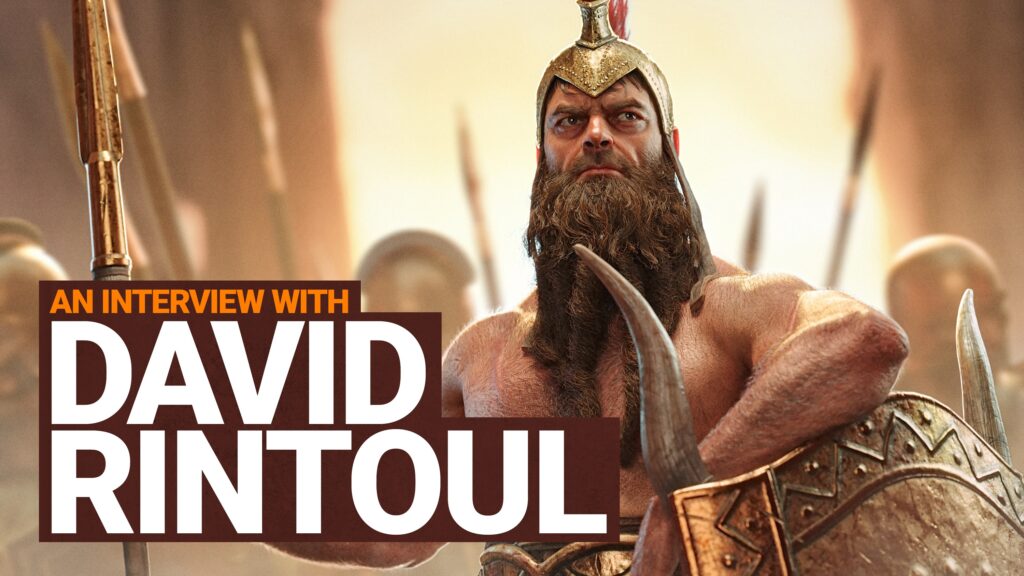Myths, Monsters, and Meaning: The Truth Behind the Myth
Languages
English
The truth behind the myth approach is one of the guiding lights behind A Total War Saga: TROY’s development – but what does it mean?
We sat down with Creative Assembly Sofia game director Maya Georgieva once more to talk about the truth behind the myth as well as gods, monsters, and everything in between.
Why the truth behind the myth?
Maya gets right to explaining the team’s thought process:
“The historical series of Total War games have a treasure trove of themes and materials to draw from – maybe more than we can actually cover, although not for lack of trying! One such period ripe for Total War representation is that of the Late Bronze Age, especially the mysterious and dynamic time of the Bronze Age Collapse – it has been on our list for a long time. However, there are objective challenges to representing such long-gone eras in an engaging and entertaining way while also checking the boxes of what’s necessary for the game to play without lagging behind recent developments.”
To make a quality addition to the Total War series, the team needed to learn much more than simply what geography and archaeological artefacts can tell us about the Bronze Age – they needed names of nations, places, people, their characters, relationships, and their conflicts. Maya emphasises: “These are the things that give soul and human face to history. We need recognisable personalities that create emotional attachment and, last but not least, we need a story to tell.”
Thanks to contemporary historians, significant numbers of literary sources, and extensive research, there is plenty of reference material for later historical eras – but not so much for the Bronze Age. However, as Maya says: “It all exists in the myths and legends of the ancient Greeks with one significant caveat – myths are far removed from reality.”
She continues: “Instead of forfeiting an attempt to expand the series into this exciting age, we decided to draw from that source – very carefully and concisely, by separating the impossible from the still less probable but feasible, until we could filter out a core that could be at the heart of a great new Total War game. We’re guided and reassured in this by the success of pioneers such as Heinrich Schliemann, who believed that there was substance behind those old tales and went on to prove this by excavating the sites of Troy and Mycenae, opening up the way for science to further explore this period of history.”
Looking at the Iliad
Homer’s Iliad is an epic tale that focuses on human conflicts and affairs – but it also features a lot of fantastical and supernatural elements. Although the ancient Greeks and Romans obviously believed in its historicity, for centuries it was considered little more than a work of fiction well outside the scope of science.
That ultimately changed when Heinrich Schliemann – more adventurer than scientist – actually discovered and excavated the sites of Troy on the hill of Hissarlik in Turkey, and then went on to also find Mycenae and Tiryns in mainland Greece. He firmly believed in the historicity of the Iliad, and although his methods attracted a lot of professional criticism, it is undoubtedly his discoveries that opened up a wider avenue for exploration of the Greek Bronze Age in light of the myths and legends for that time.
Today we have a lot of matching and cross-referenceable sources that lend credibility to different parts of the Iliad’s story. The ruins of Troy VI and VII clearly denote a period when the great fortification was destroyed by an earthquake, and there are signs of war and siege (lots of arrowheads, evidence of fires, and rooms in buildings having been compartmentalised in order to accommodate more people).
The Hittite texts – a body of sources ranging from letters between the rulers of the Hittite empire and other heads of states, legal documents, hymns, rituals, and more – have been shown to contain references to Ahhiyawa (now identified with the Achaeans – the Greeks in Homer’s epic), Wilusa (connected to Ilios/Ilion – one of the names of the city of Troy, given after the grandfather of Priam, Ilios), Taruisa (more directly referencing Troia or the surrounding region the Troad).
Maya explains: “We have the names of some rulers of Wilusa Piyama-Radu and Alaksandu – linguistically connected to Priam and Alexander (the birth name of Paris). We even have some small details like the god Apaliunas (a Hittite version of an early form of Apollo), who stands to guarantee a treaty between the rulers of Hattusa and Wilusa – and, as we know from the Iliad, Apollo is the most prominent god in Troy.
In Linear B – the syllable script adapted from the Minoan Linear A for writing in Mycenean Greek – there are names such as E-ko-to (Hector) and A-ki-re-u (Achilles) that tell us that those were given to people contemporary of the legendary events.
Even more broadly speaking, the legendary journeys of the heroes described in the works of the Epic Cycle – which besides the Iliad and the Odyssey includes the now lost Cypria, Aethiopis, Nostoi (Returns) and others – tell the tales of long sea voyages and battles on the shores and islands of the Mediterranean, which we know from history was when the infamous Sea People were causing peril in the region.
It’s fun to think of the Odyssey when you switch the point of view from the main character to the inhabitants of the places they visited that suffered the brunt of their “adventures”.
Euhemerism and authenticity
One of the key pillars of Total War games is authenticity – the ambition of creating the game’s sandbox in a manner that feels natural and true to its source while also accommodating all the eventualities that didn’t necessarily occur in history.
Maya acknowledges this, saying: “It is an important challenge – to capture the spirit of the source while also providing the necessary gameplay freedom that allows for anything to happen. So it was quite a relief when I realised our grounded approach to myths is not alien to the classical Greeks’ understanding of their legendary past – to the contrary, it is actually very fitting with their own mindset.”
She volunteers a scene from Plato’s Phaedrus that illustrates this:
Phaedrus: But tell me, Socrates, in the name of Zeus, do you really believe that legend is true?
Socrates: Actually, it would not be out of place for me to reject it, as our intellectuals do. I could then tell a clever story: I could claim that a gust of the North Wind blew her over the rocks where she was playing; and once she was killed that way people said she had been carried off by Boreas [god of the North Wind]…
This rational approach to myths is also embedded in the philosophy of the Greek mythographer Euhemerus. His approach – euhemerism – is derived from the notion that myths are exaggerated accounts of historical characters and events.
“Of course,” Maya notes, “Euhemerism is a bit extreme – it tries to explain all myths in a rational way. But it does present an interesting challenge for us while developing Troy – to try and uncover that “clever story”, in the words of Socrates, that is the possible kernel of truth from which the myths and legends sprouted. It does require an interesting mix of cynical scepticism – to ruthlessly analyse and deconstruct myths – but also sympathy towards them, so as to retain their characteristics instead of discarding them completely.”
Myths and meanings
Maya gave some examples of this euhemeristic approach to myths the team used while researching Troy:
- The myth of the god of metallurgy Hephaestus tells us he’s the son of Hera (and sometimes Zeus, but not always – which is already curious), and he was thrown to the Earth on the island of Lemnos after his birth – hence his deformity. Hera was queen of the gods, and the goddess of marriage, the sky, and the stars of heaven. Can this account relate to an astronomical event? Did the starry sky “give birth” to a meteorite that gave us metallurgy? Recent research also links the description of his physical appearance with the symptoms of arsenic poisoning associated with Bronze Age metallurgy.
- We know from myths that Zeus, lord of the thunderbolt, fought Typhoeus, the monstrous giant born from the earth and as tall as the sky, until he finally contained him under Mount Etna, the Sicilian volcano. And here’s how this same scenario played out in Chile in 2012:

Source: Wikipedia
- The myth of Bellerophon tells the story of the hero who tamed the winged horse Pegasus, travelled to Lycia on the Anatolian shores, and vanquished the monstrous Chimera – a winged, fire-breathing creature with the heads of a snake, a lion, and a goat. It’s an unusual mix and is often interpreted symbolically, but interestingly a bas relief of a Hittite sphynx found at Karkemish might explain it all too well – it checks all the boxes of this unusual creature’s description. So can we imagine the “clever story” of a Greek warlord who led a force to Lycia and found a colony expelling the local Hittite forces while also “taming” the local natural phenomenon of “eternal fires” – natural gas outlets that might very well have been interpreted as the fiery breath of the Chimera?

Source: Wikipedia
- The myth of Theseus is an interesting example, too, as it almost turns upside down when subjected to the grounded approach. Theseus was supposedly magically conceived by a princess of Troezen, the god Poseidon, and the king of Athens Aegeus, who was worried about not having a male heir and sought the help of an oracle. When the hero came of age and discovered his royal origin he travelled to Athens by land, completing six heroic labours and defeating various bandits and monsters until he could claim his position as next in line for the throne (much to the chagrin of the king’s nephews). He then went on to capture the Marathon Bull and vanquish the Minotaur on Crete, among other things. It’s an odd story if you start asking questions, for example:
- Why didn’t the king marry the princess immediately?
- Why did the hero take the long route by land instead of jumping straight on a ship to Athens?
- Why did no one at court recognise him?
But maybe, if we accept all the details, another story connects the dots better: the Athenian king did travel to the oracle and shared his story while staying at Troezen, and the princess probably was pregnant – but surely not from Poseidon. The boy did grow into a wily and powerful local warlord, who meticulously eliminated all competing bandits in the Athenian hinterland – six of them – until he became a power significant enough to question the rule of the capital. In the end, the king had to submit to the circumstances, and to save face the usurper was recognised as the true heir by a magical story – one that we all know and love even to this day. That scenario is significantly darker, but also rings much truer. And that’s the charm of grounded myths – uncovering the harsher realities behind the whimsical tales we’ve become accustomed to accepting without question.
More than monsters
It would be impossible to talk about myth without also talking about monsters – and Maya agrees.
“Strictly speaking, the Iliad does not feature a lot of fantastical characters and monsters – it focuses on larger-than-life heroes and meddlesome gods instead. Still, we cannot seriously endeavour into the realm of Greek myth and legend without acknowledging some fan favourites. And, more importantly, by doing so we complement the variety of possible army rosters and battle gameplay with some important options that would otherwise be missing or very scarce in a purely Bronze Age setting. So the inclusion of “mythical” units in Troy is justified by reasons of authenticity and even more so – by gameplay necessity.”
However, Maya also notes that their inclusion happens with two main caveats:
- “Monsters” in Troy are purely optional content – players who want to can gain access to these units in the designated spots on the map, but they exist outside the main factions’ rosters and can easily be avoided completely by the more-historically inclined
- All “mythic” units are subject to the team’s euhemeristic truth behind the myth approach to not twist the overall tone and direction of the game
Below Maya explains some of the mythical units that can be encountered in A Total War Saga: TROY as well as how they lend themselves to the game’s euhemeristic approach.
The Minotaur
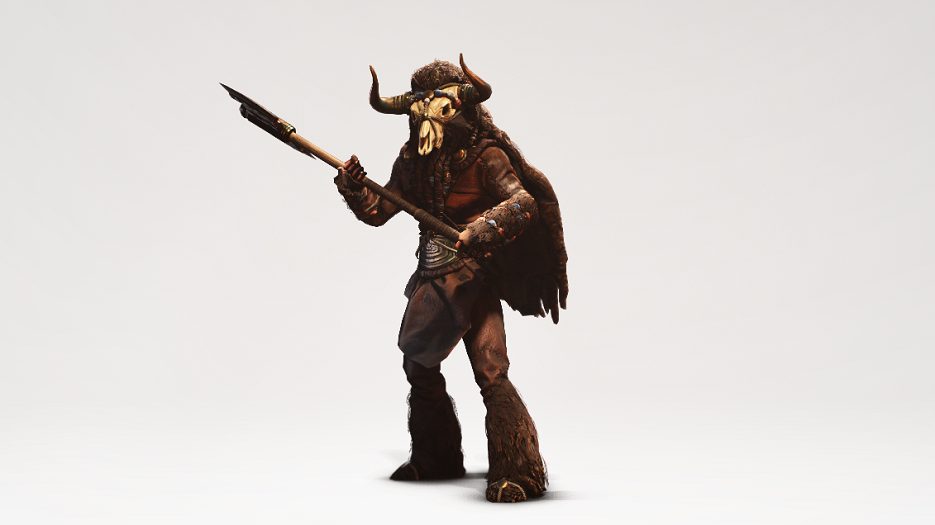
In Greek mythology, the Minotaur was a monstrous man-eating beast on the island of Crete. This iconic monster was first created when Poseidon presented King Minos with a sacrificial bull which he refused to slaughter, forcing the Greek god to repay this act of sacrilege by cursing the king’s wife to bear a child that was half bull, half man. According to the myth, Athenian youths were sent as tribute to Minos to be eaten by the monster in its lair – a maze called the Labyrinth, built by Daedalus to house the Minotaur. Ultimately the monster was slain by Theseus roughly one generation prior to the Trojan War in the Greek mythological timeline.
Scientists speculate that the basis for the Labyrinth may be the complex architecture of the Minoan palace in Knossos discovered by Arthur Evans. The name “labyrinth” may be related to the sacred double-headed axe of the Minoans – the “labrys”.
In TROY we’ve created a backstory for our Minotaur that reconciles the timelines and the fact that Homeric Crete was dominated by the Mycenaeans and not the Minoans for at least two centuries after the fall of the latter. We think of our Minotaur as a rebel or bandit king who invokes the symbols of the past to make his claim for power – he uses the bull mask and the double axe as means to connect to the Minoan heritage and incite followers.
In the game, the Minotaur can be found and recruited in specific locations – including, of course, Crete. Thanks to his size and martial skill, the Minotaur is a daunting opponent to face on the battlefields of the ancient Mediterranean.
The Cyclops
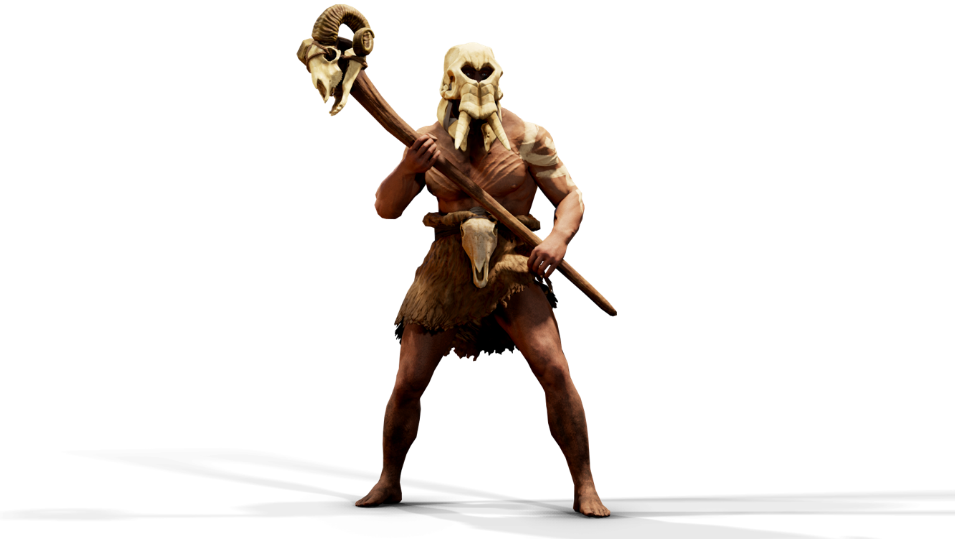
According to Homer, Polyphemus is a monstrous giant that features in the Odyssey – the story that follows the Iliad and describes the adventurous return of Odysseus to Ithaca. He lives on an island later identified as Sicily by the Greeks, and dwells in a cave along with his herd of sheep. All “Kyklopes” (“orb-eyed”) are considered savage and uncivilised man-eating giants.
Interestingly, we found that fossils of what are known as “dwarf elephants” have been found on Sicily and other islands in the Mediterranean, indicating these creatures lived there as late as 11,000 BCE. The size of these species and the shape of their skulls, where the nasal cavity looks strikingly similar to one big eye socket in the centre of the skull, is considered to be the origin of the myth of the Cyclopes – an ancient race of one-eyed giants from an earlier epoch.
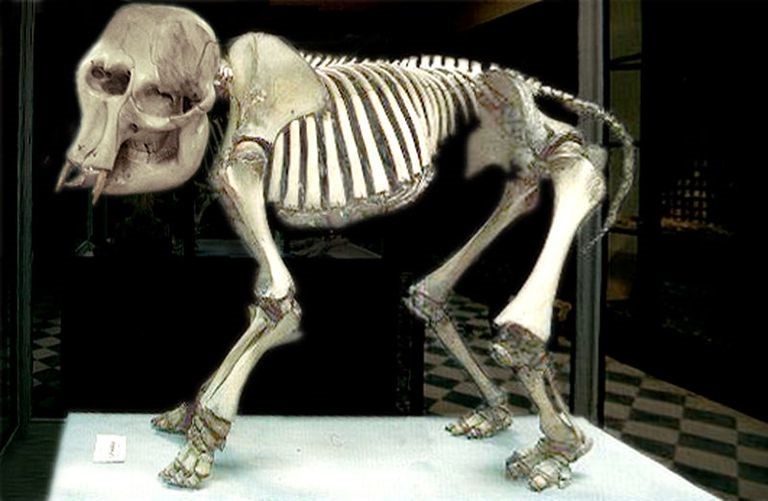
Source: Wikipedia
We gave that cyclopean skull to our Polyphemus as a helmet as well as a savage look with lots of body paint and scarification to go with his sheepskin clothes and blunt weapon.
In TROY, Polyphemus can be found and recruited on specific islands, implying that he is a “son of Poseidon” – perhaps a raider or pirate who moves between secret island hideouts.
The hulking Cyclops is a good match in combat with the Minotaur – and they are bitter rivals.
Centaurs
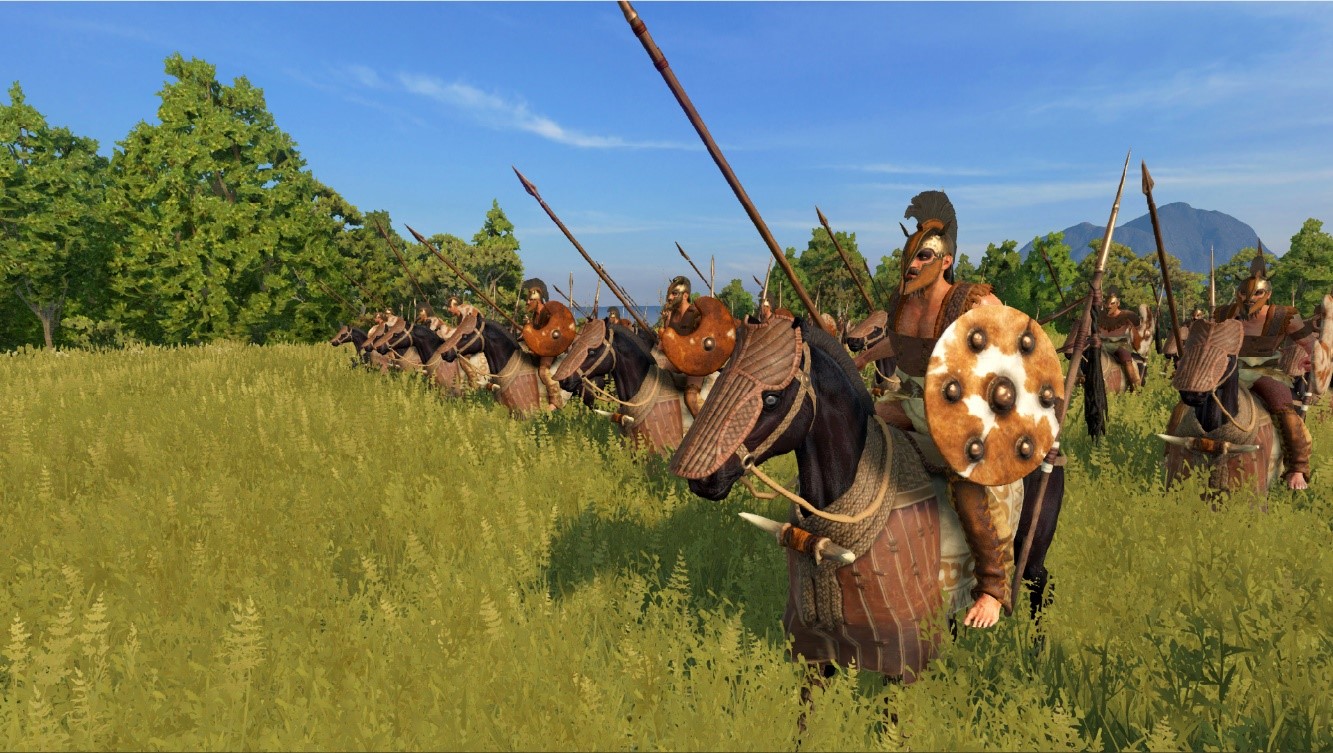
The legend of Achilles implies the existence of Centaurs – a mythical tribe of wild half-men, half-horses located in the vicinity of Mount Pelion (named after Peleus, the father of Achilles).
In the myths, Peleus was exiled in his mother’s homeland, at the foot of Mount Pelion in Thessaly, where he incurred the enmity of his royal host and was left alone to fend off a group of Centaurs unarmed. Luckily the Centaur elder Chiron helped the young hero and befriended him. Later, Chiron taught Peleus how to capture the goddess Thetis, and from their bond Achilles was born. Chiron took young Achilles and became his mentor.
In TROY, we interpret Centaurs as tribes of masterful riders who visibly appear “one with their horses” and are quite wild-looking and culturally distinct from the proto-Greek tribes that dominate the region. They can be found in the vicinity of Pelion, in the mountains of Arcadia, and on the Anatolian coast towards Rhodes.
In myths, the neighbouring tribe of the Lapiths has been credited with the invention of the horse bit and bridle, so it’s not a huge stretch to imagine the whole myth is centred around the taming and mastery of horses.
Needless to say, the Centaurs make up for the lack of other true cavalry in the game, although chariots and special light units also fulfil this role in battle.
Giants
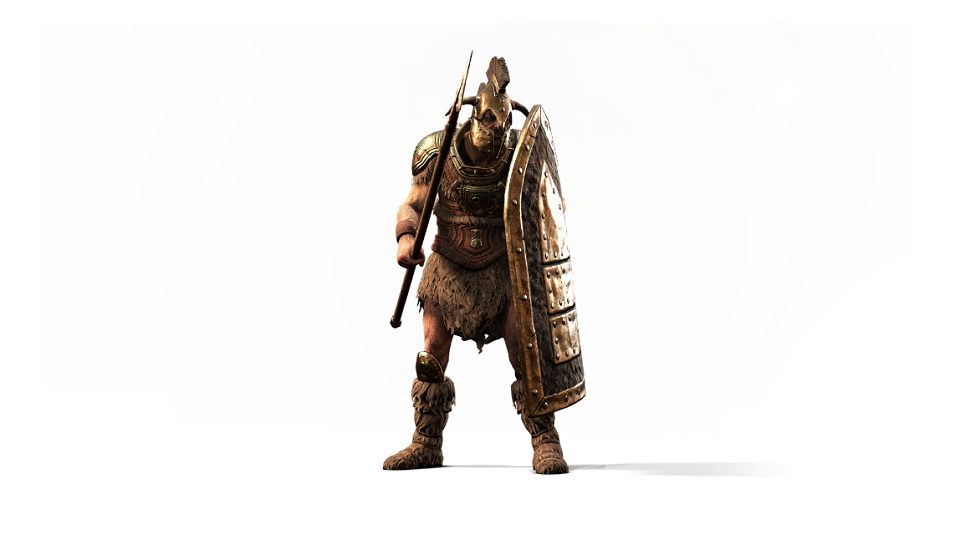
Accounts of Giants come more from the Odyssey, where on some islands the sailors encounter tribes either of or related to Gigantes – the giants of Greek mythology. The Roman historian Pausanias takes that description to mean that, for Homer, the Giants were a race of mortal men rather than mythological creatures.
In TROY, Giants can be recruited in a few locations spread evenly on the map. Similar to Centaurs, Giants fulfil a functional role in battle in an era missing true siege machinery as they are very good at assaulting gates during sieges.
The possibilities of the truth behind the myth
In addition to allowing the measured inclusion of monsters (of a sort), TROY team’s truth behind the myth approach is also worked into the way some of the game’s essential mechanics function. Maya explains:
“The grounded myth approach provides us with a framework for implementing religion and belief as part of our Divine Will system, where religious cults affect the gameplay in meaningful ways – not unlike the gods of the Iliad who meddled in human affairs. It also gives us the opportunity to explore and flesh out the opposing factions in the poem – the Trojans and Lycians – in the light of historical research into Luwians, Phrygians, and the Hittite influence on the western coast of Anatolia. For example, we represent the tension between the brothers Paris and Hector as more practical political rivalry for the inheritance of the throne of Troy. We also explore some more grounded interpretations of the legends in Epic Missions – the unique mission chains that each of the faction leaders must follow in order to achieve “Homeric victory”.”
However, Maya points out that – perhaps most of all – the truth behind the myth approach “enables us to make this game in this time period by giving us the tools to bridge the gaps in the historical record. It also helps supply an interesting framework for interpreting myths and legends, as well as identifying the truths hidden behind them. And, in the end, it provides variety and choice for those who like more or less mythology and fantastical elements in their Bronze Age.”
Onwards to Troy!
Want more behind-the-scenes peeks at the development of A Total War Saga: TROY? Take a look at our previous dev diaries on Achilles, Achaeans, and Aesthetics: The Art of TROY here or Bartering, Bronze, and Battles: TROY and the Bronze Age here.
Also make sure to keep an eye on our social media channels for all the latest TROY updates!
Simplified Chinese
神话、神兽与神秘:神话背后的真相
探寻神话背后的真相便是《A Total War Saga: TROY》开发工作的指导方向之一。不过,何谓探寻神话背后的真相呢?
我们再次与Creative Assembly Sofia的游戏总监Maya Georgieva一同探讨了神话背后的真相,以及众神、怪兽等涉及到的一切事物。
为何选择揭开神话背后的真相?
Maya直截了当地说明了团队的思考过程:
“《Total War》系列游戏中的历史作品从来不缺乏可发掘的题材与素材——而我们真正能覆盖到的或许只是其中一部分,当然了,并不是因为我们没尽力!其中一个适合《Total War》发挥的题材便是青铜时代晚期,特别是神秘而动荡的青铜时代崩溃期——对此我们早有计划。不过,要想以一种引人入胜又充满乐趣的方式来表现如此久远的时代,同时还要考虑如何满足各种条件、让游戏内容不落后于当今技术的发展,从客观上来说的确是一大挑战。”
要给《Total War》系列增添一部高质量的新作,开发团队不仅需要了解从地理与考古文物中所能获取有关青铜时代的信息,还要查明国家、地区和人物的名称,以及他们的特点和彼此之间的关系与冲突。Maya强调说:“正是这些事物为历史赋予了灵魂与人性。我们需要通过鲜明的特性来塑造情感依附,而且同样重要的是,我们必须借此讲述一个故事。”
通常对一个时代来说,当时的历史学家、浩如烟海的文学作品和广泛的研究能够为后世提供大量参考资料,但青铜时代的资料相对来说要少得多。不过正如Maya所说:“这段历史都记载于古希腊的神话传说之中,可是有个很大的问题:神话通常与现实相去甚远。”
她接着说:“为了不错失将系列作品拓展到如此激动人心的时代,我们小心而精准地以这些神话传说为本,将超现实的描述与那些虽然看起来有些怪异,但至少可能存在的事物分离开来,层层分析、剥丝抽茧,最终使其能够成为《Total War》系列新作的核心内容。海因里希·施里曼(译注:德国考古学家)这类伟大先驱者成功指引并鼓舞着我们,他坚信在古老的传说背后必有其本源,并通过发掘特洛伊与迈锡尼的遗址证明了这一点,为进一步研究这段历史提供了科学的途径。”
回顾《伊利亚特》
荷马所著的《伊利亚特》是一部聚焦于人类之间爱恨情仇的史诗故事,但其中也包含了各种幻想与超自然的元素。虽然古希腊与古罗马的人们对该书的历史意义深信不疑,但数个世纪以来,人们都不过将此书看作一部远超科学范畴的奇幻作品。
而当海因里希·施里曼(与其说他是位科学家,不如说他是个不折不扣的探险家)在土耳其的希萨立克山发现并发掘了特洛伊城遗址、接着又在希腊本土发现了迈锡尼城与梯林斯城后,这一切发生了翻天覆地的变化。施里曼坚信《伊利亚特》的历史意义,虽然他的发掘方式招致了不少专业批评,但这些发现无疑为探索希腊青铜时代,以及当时的神话与传说,提供了更为宽阔的道路。
如今,通过各种互相匹配、互相印证的资料,我们得以证实《伊利亚特》所记述的故事中各个部分的可信度。第六期与第七期的特洛伊遗址清楚地表明,当时宏伟的城墙曾被地震所摧毁,并且留下了战争与围城的迹象(大量箭头、火灾痕迹,以及建筑内部被分隔开来以便容纳更多人)。
赫梯文字中,包括赫梯帝国统治者与其他城邦首领之间的信件、法律文书、赞美诗、仪式等等,提到了亚锡雅瓦(现被认为是“亚该亚人”,即荷马史诗中的希腊人),维鲁萨(与伊利奥斯/伊利昂有关——特洛伊城的别名之一,取自普里阿摩斯的祖父伊利奥斯)以及塔鲁伊萨(更直接指特洛亚或是周边的特洛德地区)。
Maya解释说:“我们在其中看到了维鲁萨统治者的名字——皮亚马拉都与阿拉克桑都——语言上与普里阿摩斯和亚历山大(帕里斯出生时的名字)有关。我们还注意到一些小细节,例如神祇阿帕罗纳斯(赫梯文化中阿波罗的早期形态),他守护着哈图萨与维鲁萨之间的协定——而如同我们从《伊利亚特》中所知的那样,阿波罗正是特洛伊最为显赫的神祇。”
在线性文字B(迈锡尼希腊使用的音节书面文字,由米诺斯的线性文字A改造而来)中出现了诸如厄-克-托(赫克托耳)与阿-基-里-乌(阿喀琉斯)这样的名字,由此我们可以得知,这些名字代表着当时一些重大事件中的人物。
由此说开去,《史诗集群》的作品中所记载的英雄们的传奇旅程——不仅包括《伊利亚特》与《奥德赛》,还有现已散佚的《塞普里亚》、《埃提俄庇斯》与《诺斯托伊》(又名《归途》)等等——描述了漫长的海上航行以及在地中海岛屿及沿岸发生的战斗,而根据历史,我们可以得知当时恶名昭彰的“海上民族”正对这一地区造成巨大的危害。
若将目光从主人公转移到所经之地的原住民身上,想必会对《奥德赛》产生更加有趣的理解——主人公的“历险”令这些居民的家园受到了巨大的冲击。
“欧赫迈罗斯主义”与真实性
《Total War》系列游戏的关键核心之一便是真实性:是致力于以一种自然而忠实于本源的方式创造游戏世界的雄心壮志,同时也容许种种历史上不见得发生过的可能结果。
Maya也赞同了这一点,说道:“这是一项重大的挑战:既要捕捉到史料的灵魂,也要为游戏提供足够的自由度,让玩家体验到各种各样的可能性。因此,当我发现我们对神话的理性解读与古希腊人对自己传奇历史的理解并不相悖时,着实是松了一口气。这些解读恰好非常符合古希腊人的思维模式。”
她接着从柏拉图的《斐德罗篇》中引用了一段场景来证明这一点:
斐德罗:可是宙斯在上,苏格拉底啊,请你告诉我,你真的相信那些传说吗?
苏格拉底:说实话,我大可以像其他的智者那样斥之为虚假。我大可以说个聪明的小故事:她(译注:此处指欧丽泰亚)在岩石间玩耍时被一阵北风吹走,并因此丢了性命;而后,人们便说她被波瑞阿斯(北风之神)带走了……
这种对神话进行理性研究的观念也深植于古希腊神话学家欧赫迈罗斯的哲学中。他的研究方式——也就是欧赫迈罗斯主义——源自这样一种观点,即神话实际上是对真实历史人物与事件的夸张描述。
“当然了,”Maya指出,“欧赫迈罗斯主义也有些极端:它试图以理性的方式来解释所有的神话。但在我们开发《Troy》的过程中,这种方式也的确为我们提供了颇为有趣的挑战——尝试揭开神话背后的真相,或者用苏格拉底的话来说,‘小故事’。或许正是从这些‘小故事’中诞生了形形色色的神话与传说。因此,我们需要拥有犬儒学派式的怀疑主义,无情地分析与解构神话,也要赞同其存在,以便保留其特性,而非将其彻底抛弃。”
神话与其含义
Maya给出了一些团队在研究特洛伊时采用欧赫迈罗斯主义方式的例子:
- 根据有关锻造之神赫淮斯托斯的神话,他是赫拉之子(有说法称他是赫拉与宙斯共同诞下,又有说法称是赫拉独自生下——这点就够奇怪了),在出生后被扔到人间的利姆诺斯岛上,因而落下了残疾。赫拉是天后,也是司掌婚姻、天空与星辰的女神。这事件是否代表了某种天文事件呢?星空是否“孕育”了一颗为我们启迪了冶金学的陨石?而最近的研究也发现,对他外貌的描述与青铜时代的冶金工业所造成的砷中毒症状有所相似。
- 根据神话记载,雷电之王宙斯曾与诞生于大地、与天同高的巨大怪物堤福俄斯战斗过,然后终于将他制服在西西里火山埃特纳山下。而在2012年,在智利上演了同样的一幕:

来源: Wikipedia
- 柏勒洛丰的神话讲述了驯服了飞马珀伽索斯的英雄,随后他来到安那托利亚海岸边的吕基亚,并击败了可怕的客迈拉——这只长有翅膀、口吐火焰的怪兽长着三只截然不同的脑袋:蛇头、狮头与羊头。这种组合十分奇特,并通常被人认为只是象征意义,但有趣的是,在卡尔克米什发现的赫梯斯芬克斯浮雕或许能够充分解释这一切——它符合这只奇特生物的所有描述。因此我们可以想象出这样一个“小故事”:一位希腊领主率领军队来到吕基亚,建立了殖民地并开始驱逐当地的赫梯军队,还“驯服”了该处的“永恒之火”这种自然现象——天然气的出口或许正好可以描绘成客迈拉那炽焰般的吐息?

来源:Wikipedia
- 忒修斯的神话也同样是个有趣的故事,因为理性的解读几乎会将整个故事完全反转。据说忒修斯是由特洛伊西纳公主、海神波塞冬与雅典国王埃勾斯三人共同诞下,这一点颇为神奇。由于埃勾斯担心自己无法诞下男性子嗣,因此寻求了神谕的帮助。当这位英雄成年并发现了自己的王室血统后,决定通过陆路前往雅典,完成了六项英勇壮举,并击败了无数强盗与怪物,直到能够宣布自己便是王位的继承人(此举令国王的侄子们气恼不已)。随后他又抓获了马拉松野牛,消灭了克里特岛上的弥诺陶洛斯,并立下了其他丰功伟绩。或许你会觉得这个故事很奇怪,会产生各种疑问,比如说:
- 为什么国王不直接迎娶公主?
- 为什么这位英雄不直接乘船去雅典,而是要走遥远的陆路?
- 为什么宫廷里没人认出他?
但如果我们接受了这些细节,或许会有个故事能够更好地将这些部分连接在一起:雅典国王的确寻求了神谕,并在特洛伊西纳将他的故事告诉了别人,公主或许也真的怀孕了——但显然并非波塞冬的子嗣。某个孩子长大后的确成为了一名狡猾而强大的地方领主,并一个不落地消灭了雅典腹地所有成规模的强盗势力——共有六个——而后成为了足以动摇首都统治的显要人物。最终,国王在形势所迫之下让位于他。为了保全脸面,篡位者通过一个神奇的故事将自己粉饰为真正的继承人——时至今日,这个故事仍被我们津津乐道。这个故事显然黑暗得多,但也真实得多。这就是探索神话的魅力——揭开那些我们早已习以为常的异想天开,发现隐藏其后的严酷现实。
怪兽非兽
若要谈到神话,则不可避免地会提到怪兽——Maya也同意这一点。
“严格来说,《伊利亚特》中并未对奇幻人物或是怪兽施以太多笔墨——书中着重刻画的是传奇英雄和爱管闲事的众神。不过,如果我们不描绘一些受粉丝群体喜爱的事物,就无法真正踏入希腊神话与传说的领域。而且更重要的是,我们能够利用这些重要的元素丰富军队的种类,令游戏方式更加多样。如果拘泥于纯粹的青铜时代设定,这些元素将不复存在,或是几乎没什么戏份了。因此在《Troy》中加入‘神话’部队十分合理,不仅出于真实性的需要,更是缘于游戏性的必要。”
不过,Maya也提到加入这些部队有着两个重要的限制:
- 《Troy》中的“怪兽”完全是可选内容——希望得到它们的玩家可以通过地图上的特定地点获得这些部队,但任何主要派系都不可直接进行征募,以便更倾向于历史真实性的玩家们避开他们
- 所有“神话”部队都要基于团队通过欧赫迈罗斯主义获取的“背后真相”进行设定,不能与游戏的基调与大方向发生冲突
在下方,Maya阐释了一些你会在《A Total War Saga: TROY》中遇到的神话部队,以及他们将如何与游戏所采用的欧赫迈罗斯主义研究方式保持一致。
弥诺陶洛斯

在希腊神话中,弥诺陶洛斯是居住在克里特岛上的凶恶野兽,以人类为食。这只著名怪物的诞生缘于波塞冬向米诺斯王赠送了一只献祭用的公牛,但米诺斯却拒绝将其宰杀。这一渎神之举令海神大为光火,于是诅咒了国王的妻子,令她诞下了一名半人半牛的生物。根据神话记载,雅典人必须向米诺斯王献上童男童女,这些孩童将被扔进怪物的巢穴喂养弥诺陶洛斯——这座巢穴名为“Labyrinth”(“迷宫”),乃是代达洛斯为将怪物困于其中所建。最终,这只怪物被忒修斯所杀。根据希腊神话的时间线,此事大约发生在特洛伊战争的一个世代之前。
科学家们推测,Labyrinth可能源自英国考古学家阿瑟·埃文斯在克诺索斯发现的米诺斯宫殿。这座宫殿错综复杂,或许正为传说提供了素材。“labyrinth”之名可能与米诺斯人使用的双刃圣斧——“labrys”有关。
在《TROY》中,我们为弥诺陶洛斯创造了一个背景故事,重新调整了时间线。事实上,在米诺斯人衰落后的至少两个多世纪里,荷马史诗中的克里特岛都是由迈锡尼人而非米诺斯人统治的。我们将游戏中的弥诺陶洛斯看作一名叛军首领或强盗头子,他利用过去的象征来发展自己的势力——戴上公牛面具、拿起双刃斧,以此和米诺斯传统穿凿附会,并煽动追随者。
在游戏中,只能在特定地区发现并征募弥诺陶洛斯——当然,其中便包括克里特。由于弥诺陶洛斯体型巨大、武艺过人,在古代地中海的战场上将令对手们闻风丧胆。
独眼巨人

据荷马记载,波吕斐摩斯是《奥德赛》中出现的一位可怕的巨人——该作品讲述了《伊利亚特》之后发生的故事,以及奥德修斯返回伊萨基的途中所经历的艰难险阻。波吕斐摩斯居住在一座岛屿上(后来被希腊人认为是西西里岛),与他的羊群一起生活在洞穴中。所有的“库克罗普斯”(即希腊语中的“独眼巨人”,意为“球眼”)都被看作是粗鄙野蛮的食人巨人。
有趣的是,我们在西西里岛和地中海地区的其他岛屿上发现了一种叫做“矮象”的生物化石,根据化石推断,这些生物在该地区生活的历史至少可追溯到公元前11000年。考虑到这种生物的体型和头骨的形状(其鼻腔看起来非常像一个巨大的眼眶),很有可能便是神话中独眼巨人的起源——根据神话的描述,这些巨人是来自上古时期的古老种族

来源: Wikipedia
我们让波吕斐摩斯戴上了这种巨大的头骨作为面具,并通过大量身体彩绘与战痕来塑造出一副野蛮的模样,使他的外表与羊皮衣服和巨棍武器相匹配。
在《TROY》中,可以从特定的岛屿发现并征募波吕斐摩斯,以此体现他作为“波塞冬之子”的身份——比如作为一名劫掠者或者海盗,在各个岛屿的藏身处之间辗转。
高大笨重的独眼巨人正好在战斗中能够与弥诺陶洛斯相匹敌——他们可以算是死对头了。
半人马

阿喀琉斯的传奇故事中暗示了半人马的存在——这个神话中的部落由半人半马的野蛮生物组成,位于珀利翁山附近(因阿喀琉斯之父佩琉斯而得名)。
据神话记载,佩琉斯在母亲的故土遭到流放,来到了色萨利的珀利翁山脚下。在那里,他与当地皇室发生了冲突,被留下来手无寸铁地独自抵御一群半人马。幸运的是,半人马长者喀戎帮助了这位年轻的英雄,并与他成为了朋友。后来,喀戎教导了佩琉斯如何俘获女神忒提斯的芳心,而他们的结合诞下了阿喀琉斯。喀戎带走了年幼的阿喀琉斯,并成为了他的导师。
在《TROY》中,我们将半人马解释为“人马合一”的骑手部落,他们外表野蛮但骑术高超,在文化上与该地区的典型希腊部族截然不同。可以在珀利翁山附近、阿卡迪亚山脉以及靠近罗得的安那托利亚海岸找到半人马。
在神话中,邻近的拉皮斯部落发明了马嚼子与马笼头,因此不难想象,整个神话都是围绕着驯马与驭马展开的。
毫无疑问,半人马弥补了游戏中骑兵的不足,虽说战车与特殊轻装部队也可以在战斗中胜任该角色。
巨人

有关巨人的记载主要来自《奥德赛》。在一些岛屿上,水手们遇到了一群癸干忒斯(或与他们有关的)部落——也就是希腊神话中的巨人。罗马历史学家帕萨尼亚斯对此解释说,荷马认为巨人乃是凡人的种族,而非神话造物。
在《TROY》中,可以从均匀分布在地图上的几个地区征募巨人。与半人马类似,巨人在缺乏攻城器械的时代里也扮演了重要的角色——他们非常擅长在攻城战中突破城门。
探索神话背后的真相有何意义?
《TROY》团队对神话背后真相的挖掘除了能够令(某种意义上的)怪物加入游戏之外,也影响着游戏中一些基本机制。Maya解释说:
“理性的神话研究方式为我们提供了神恩机制的基本框架。在该机制中,宗教与信仰会以各种方式影响游戏进程,就像《伊利亚特》中插手人类事务的神明一样。由此,我们也可以根据有关卢维人、佛里吉亚人和赫梯人对安那托利亚西海岸影响的历史研究,来探索并充实史诗中的两大对立阵营——特洛伊人与吕基亚人。比方说,我们将帕里斯与赫克托耳兄弟之间的不和归结于争夺特洛伊王位继承权的政治斗争,这样一来使得他们之间的争斗更加贴近实际。我们还通过史诗任务探索出一些对传说更加理性的解读——若要取得‘荷马史诗胜利’,每个势力领袖都必须完成这组独特的任务序列。”
不过,Maya指出——或许也是最重要的一点——揭开神话背后真相的方式“为我们提供了跨越时代长河的桥梁,使我们能够制作出这款关于神话时代的游戏。此外,它还为我们提供了一个有趣的研究概念,可以经由这种途径来解读神话与传说,并发现隐藏在它们背后的真相。最后,对于那些喜欢或是不喜欢青铜时代中神话与奇幻元素的人们来说,这种方式也提供了更多样化的选择。”
出发,前往特洛伊!
想要了解更多有关《A Total War Saga: TROY》的幕后故事吗?可以在此查看我们先前的开发日志:Achilles, Achaeans, and Aesthetics: The Art of TROY或Bartering, Bronze, and Battles: TROY and the Bronze。
也请记得关注我们的社交媒体账号,获取有关《TROY》的一切最新消息!

